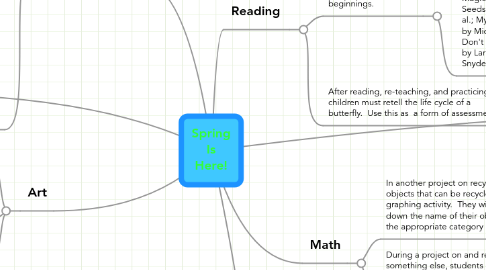Spring Is Here!
von Diana Lai


1. Social Studies
1.1. Cultures that celebrate the spring time: Chinese Spring Festival, Easter, Scotland's Whuppity Scoorie, Russia's Maslenitsa. Children can compare different holidays with each one and develop their own Spring holiday as a class.
1.2. How farmers tend to the earth because it is their job. Leads into agriculture and its industry.
1.3. Talk about the concept of recycling. Teach about the different ways people can help the earth by recycling, reusing, and reducing. Go on a recyling field trip around the school.
2. Science
2.1. Planting flower and vegetable seeds in a clear baggie or plastic cup. Using the Scientific Method, students will mainly hypothesize, experiment, observe, record, refine idea, and reach conclusion.
2.2. Studying the different parts of a seed and plant. Learning the stages of seed/plant life.
2.3. The stages of a butterfly.
2.4. Changes of weather; revisit the four seasons. Teach about different kinds of weather (windy, sunny, rainy, cloudy, etc). Children can make daily observations for 2 weeks and describe the changes by recording them down.
3. Art
3.1. Butterflies (made out of tissue paper and clothespins).
3.2. Creating flowers and plants using scrap paper, pipe cleaners, glitter, and natural artifacts such as sticks, leaves, flower petals, dirt, and grass.
3.3. New node
4. Movement
4.1. I have an activity where children can move their whole bodies while expressing their vocabulary knowledge of descriptive words. When I call out: Boys and Girls, show me a tall tree! Children can stretch their hands and stand on tip-toe while imitating a very tall tree. Plus, their fingers would act like the sharp branches. When I ask for a short tree, they could squat to the ground and hug their knees.
5. Reading
5.1. Read literature based on Spring, planting, baby animals, and new beginnings.
5.1.1. Caterpillar Spring, Butterfly Summer by Susan Hood and Claudine Gvry; Clifford's Spring Clean-Up by Norman Bridwell; Ten Seeds by Ruth Brown;The Tiny Seed by Eric Carle; The Magic School Bus Plants Seeds by Joanna Cole, et al.; My Big Green Teacher by Michelle Y. Glennon; Don't Throw That Away! by Lara Bergen and Betsy Snyder.
